
The Calico 9mm Light Weapons System
This is what I would consider to be the assault version
of these unique weapons. The 9mm calico is (or at any rate, was) available
in a pistol or carbine version, using either 50 or 100 round magazines. There
is also a full auto version for police and military use. The method of operation
uses a two piece, delayed roller block, bolt which is the same action type
used in the Spanish CTME rifles, and the well regarded H&K G-3 and variants.
This action was designed in Germany towards the end of the Second World War,
and is reliable, sturdy, and not greatly affected by variations in powder
charge. There is no gas tube or operating rod, nothing to adjust or go out
of alignment, and few moving parts. To add to the ease of maintenance, these
arms are made primarily out of polymers, and alloys. This section covers
the features, operation, construction, and design of the 9mm series of Calico,
also known as the Liberty series. Covered here are the elements common to
all 9mm calicos.
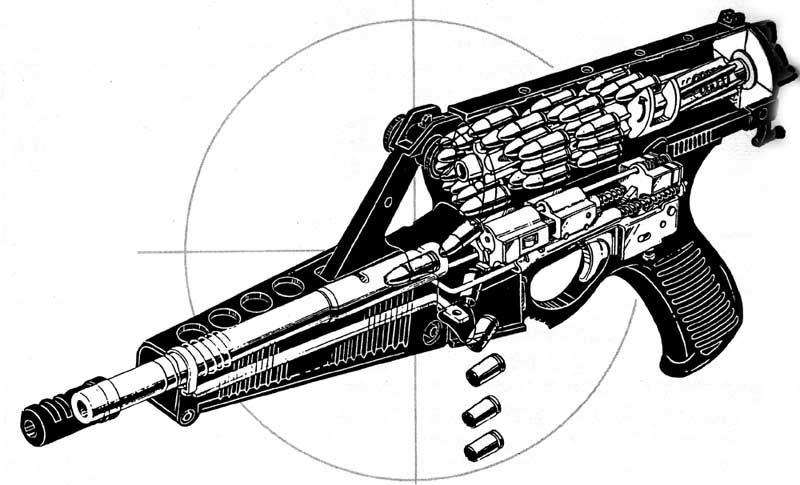 The gun breaks down into, essentially, three pieces: the magazine,
the upper receiver, and the lower receiver. Disassembly instructions, and
cleaning tips are given in a separate section. The controls are simple.
There is a cocking lever on the left side of the receiver. This lever is
separate from the actual bolt, and does not reciprocate with it, as the weapon
fires. Though the bolt is not held back after the last shot, there is a bolt
hold open lever, on the right side of the receiver. Pushing the hold open
while the bolt is pulled back, will lock it open. To release the bolt, the
lever is pushed again; simple. There is also an ambidextrous safety, and
then the trigger itself. These controls are shown in the photo below, which
may be brought up in an enlarged version by clicking on it (as can all pictures
on this page). Also visible in the photo is the pressure pad, just behind
the trigger, which activates the laser sight which I mounted near the muzzle
on the pistol version of the gun..
The gun breaks down into, essentially, three pieces: the magazine,
the upper receiver, and the lower receiver. Disassembly instructions, and
cleaning tips are given in a separate section. The controls are simple.
There is a cocking lever on the left side of the receiver. This lever is
separate from the actual bolt, and does not reciprocate with it, as the weapon
fires. Though the bolt is not held back after the last shot, there is a bolt
hold open lever, on the right side of the receiver. Pushing the hold open
while the bolt is pulled back, will lock it open. To release the bolt, the
lever is pushed again; simple. There is also an ambidextrous safety, and
then the trigger itself. These controls are shown in the photo below, which
may be brought up in an enlarged version by clicking on it (as can all pictures
on this page). Also visible in the photo is the pressure pad, just behind
the trigger, which activates the laser sight which I mounted near the muzzle
on the pistol version of the gun..
These weapons have a front sight, adjustable for windage
and elevation via a pair of knurled wheels. This front sighting system is
quite satisfactory, though I have some concerns over the design of the rear
sight. The rear sight is a simple notch, molded into the top of the magazine.
It carries the currently fashionable white dots on either side of the notch.
In some of the later vintage magazines, there is also a flip up peep sight.
My only problem with this sight should be obvious. Precision shooting is
impossible with such a system for a couple of reasons. There is the matter
of variation between magazines. Unless every magazine mounts to the receiver
in the exact same way, the point of aim will be different. Unless every magazine is molded precisely the same, with
the sights molded, finished, and aligned exactly the same, the point of
aim will be different. It is clearly not cost effective, or even possible
to ensure this level of conformity in these magazines. Even if only one magazine
is used with the gun, the play within the magazine catches, would seem to
invite a shift in point of aim every time the magazine is removed for reloading.
The possible slight flexing of the plastic within the magazine body, would
seem to insure that the point of aim will shift even without the magazine
being removed from the gun. There was a similar problem noted with the excellent
Dan Wesson revolvers, when they were introduced. The Dan Wesson features
interchangeable barrels of assorted lengths. This feature was initially claimed
to give the flexibility of instant barrel change. The problem was that the
sights had to be readjusted at every change, making the guns somewhat less
flexible than was first thought. This may not seem like a major concern in
a weapon, like the Calico, so obviously designed to produce volume fire,
but I at least like to maintain the illusion that I am a precision shooter.
The solution for this problem is a scope mount, or laser sight mount, both
still available from Calico, and from select distributors.
different. Unless every magazine is molded precisely the same, with
the sights molded, finished, and aligned exactly the same, the point of
aim will be different. It is clearly not cost effective, or even possible
to ensure this level of conformity in these magazines. Even if only one magazine
is used with the gun, the play within the magazine catches, would seem to
invite a shift in point of aim every time the magazine is removed for reloading.
The possible slight flexing of the plastic within the magazine body, would
seem to insure that the point of aim will shift even without the magazine
being removed from the gun. There was a similar problem noted with the excellent
Dan Wesson revolvers, when they were introduced. The Dan Wesson features
interchangeable barrels of assorted lengths. This feature was initially claimed
to give the flexibility of instant barrel change. The problem was that the
sights had to be readjusted at every change, making the guns somewhat less
flexible than was first thought. This may not seem like a major concern in
a weapon, like the Calico, so obviously designed to produce volume fire,
but I at least like to maintain the illusion that I am a precision shooter.
The solution for this problem is a scope mount, or laser sight mount, both
still available from Calico, and from select distributors.
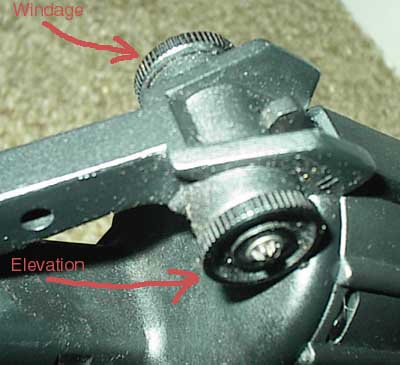 I am in the process of getting a scope mount for the use
of a Bushnell Holosight on the carbine version of this weapon. My Calico
pistol is already equipped with a laser sight, which should be sufficient
for the short ranges at which a pistol is best employed. The scope mount
itself, takes the form of a cage which fits around the cylinder of the magazine,
and is secured with four screws set around the magazine catches. There is
a standard weaver base, sitting centered over the magazine body. This puts
the scope rather high on the gun, but no more so than the numerous mounts
available for the M-16/AR-15 series of rifles. Though I do not yet posses
the scope mount or the laser mount, I do have scans of them, from old magazine
articles, to display on this page. In contrast to the placement of the scope
mount, the laser mount sits rather low on the weapon. The design of this
mount is somewhat dated, and the mount itself is not really required for
the later generation of very compact laser sights, constructed with laser
diodes. The mount was designed almost a decade ago when tubes were still
being used to generate lasers.
I am in the process of getting a scope mount for the use
of a Bushnell Holosight on the carbine version of this weapon. My Calico
pistol is already equipped with a laser sight, which should be sufficient
for the short ranges at which a pistol is best employed. The scope mount
itself, takes the form of a cage which fits around the cylinder of the magazine,
and is secured with four screws set around the magazine catches. There is
a standard weaver base, sitting centered over the magazine body. This puts
the scope rather high on the gun, but no more so than the numerous mounts
available for the M-16/AR-15 series of rifles. Though I do not yet posses
the scope mount or the laser mount, I do have scans of them, from old magazine
articles, to display on this page. In contrast to the placement of the scope
mount, the laser mount sits rather low on the weapon. The design of this
mount is somewhat dated, and the mount itself is not really required for
the later generation of very compact laser sights, constructed with laser
diodes. The mount was designed almost a decade ago when tubes were still
being used to generate lasers.
The use of a scope, or laser mount is particularly called
for because of the extreme accuracy of these guns. In a properly sighted
weapon, I have shot three inch groups, and better, at 100 yards. This is
approaching rifle level accuracy, and actually exceeds the accuracy of many
assault rifles. To handicap such accuracy with such an imprecise set of sights
is to waste much of the potential of these interesting little guns. Shown
below are the dated design of the laser, rail mount, and the metal cage design
of the scope mount.
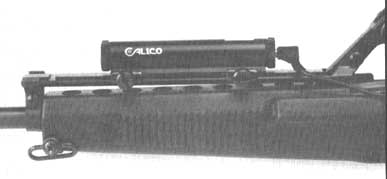
I apologize for the poor quality of the illustrations. I will replace the
scan of the scope mount with a photograph of my own, once I receive it,
and have used it to mount a Bushnell Holosight. I am not likely to ever
get a laser rail mount for the reasons already given. In addition to the
Laser, and scope mounts, Calico offers an under barrel flashlight mount
a bipod, and even a brass catcher, which uses a spring mount to fasten a
small bag under the ejection port. The bag is said to hold 150 rounds, and
seems to be a great alternative to having to chase your brass, or crawl
around the range or field looking for it. Other accessories include a crank
operated speed loader, a "Kelly" grip, and a number of different stock styles,
some extendable, and some fixed. There are also the magazines, of course,
in either the 50 or 100 round versions, but it has recently been decided
that we may not be trusted to own these unless we are in the police or the
military. 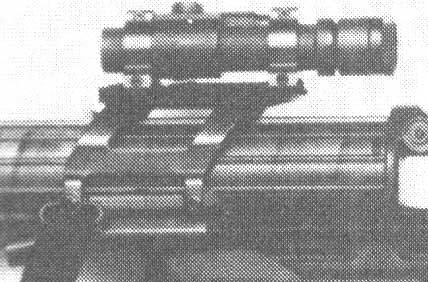 This law will only be in effect until 2004, and we can hope for some relief,
and for some better men in office than the proven felon who currently resides
in the White House. Soapbox aside, I am hoping for a resurrection of sorts,
when the Calico is no longer so hobbled by the inept and unfortunate restrictions
that we are presently burdened with. For those who are unfamiliar with the
weapon, I will give the firing procedures below. There will also be a copy
of the original Calico manual, which I have scanned in, put up on this sight
in the near future. Those wishing to own a Calico are in an unenviable position
right now. The production numbers are on another page, but only around 10,000
of these guns are out in civilian hands right now, in 9mm. This number can
not possibly be added to before the end of the so called "Crime Bill" of
1994. This makes the acquisition of a Calico an expensive proposition, and
the procuring of the magazines, more expensive still. Those who still have
a desire to own one, can get a start on my links page. You are unlikely to
find one at you local dealer, but it is possible find them on gun auctions
on the web, and at a few specialty dealers, also on the web. I will have
these places in my links soon, but I must mention a couple of things. If
you live in the sorry state of california, or new jersey, or, in the near
future, new york, you are probably not going to be able to legally order
one of these guns. If you are living in one of the more enlightened states,
you will have to arrange for transportation to a FFL holder. Shipping and
the fee to the FFL holder will probably add fifty to seventy five dollars
to the cost of the gun. Gun prices are hovering around the thousand to twelve
hundred dollar mark, though I expect them to rise sharply if the wooden wonder
(al gore) is inflicted upon the office of the President.
This law will only be in effect until 2004, and we can hope for some relief,
and for some better men in office than the proven felon who currently resides
in the White House. Soapbox aside, I am hoping for a resurrection of sorts,
when the Calico is no longer so hobbled by the inept and unfortunate restrictions
that we are presently burdened with. For those who are unfamiliar with the
weapon, I will give the firing procedures below. There will also be a copy
of the original Calico manual, which I have scanned in, put up on this sight
in the near future. Those wishing to own a Calico are in an unenviable position
right now. The production numbers are on another page, but only around 10,000
of these guns are out in civilian hands right now, in 9mm. This number can
not possibly be added to before the end of the so called "Crime Bill" of
1994. This makes the acquisition of a Calico an expensive proposition, and
the procuring of the magazines, more expensive still. Those who still have
a desire to own one, can get a start on my links page. You are unlikely to
find one at you local dealer, but it is possible find them on gun auctions
on the web, and at a few specialty dealers, also on the web. I will have
these places in my links soon, but I must mention a couple of things. If
you live in the sorry state of california, or new jersey, or, in the near
future, new york, you are probably not going to be able to legally order
one of these guns. If you are living in one of the more enlightened states,
you will have to arrange for transportation to a FFL holder. Shipping and
the fee to the FFL holder will probably add fifty to seventy five dollars
to the cost of the gun. Gun prices are hovering around the thousand to twelve
hundred dollar mark, though I expect them to rise sharply if the wooden wonder
(al gore) is inflicted upon the office of the President.
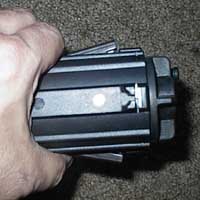 magazine is snapped into place between the dual magazine catches. With
the magazine in place, the cocking lever is pulled back, and released, cocking
the gun, and charging it. With the safety lever pushed forward, the gun
may be fired by pulling the trigger. There is no auto hold open for the
bolt, but the ammunition supply may be gauged by a series of transparent
circular windows running in a row down the top of the magazine. Empty magazines
may be removed by grasping the magazine and depressing the catches on each
side. The recoil on the pistol, and particularly the carbine, is negligible,
and the trigger, though not what I would call crisp, is light and even.
The pistol balances quite well with the 50 round magazine, though it is
rather awkward with the 100 rounder. The kelly grip may be a handy option
for those who have been shooting pistols for any length of time, and have
formed certain habits. The reason for this is that the gun requires a two
handed
magazine is snapped into place between the dual magazine catches. With
the magazine in place, the cocking lever is pulled back, and released, cocking
the gun, and charging it. With the safety lever pushed forward, the gun
may be fired by pulling the trigger. There is no auto hold open for the
bolt, but the ammunition supply may be gauged by a series of transparent
circular windows running in a row down the top of the magazine. Empty magazines
may be removed by grasping the magazine and depressing the catches on each
side. The recoil on the pistol, and particularly the carbine, is negligible,
and the trigger, though not what I would call crisp, is light and even.
The pistol balances quite well with the 50 round magazine, though it is
rather awkward with the 100 rounder. The kelly grip may be a handy option
for those who have been shooting pistols for any length of time, and have
formed certain habits. The reason for this is that the gun requires a two
handed 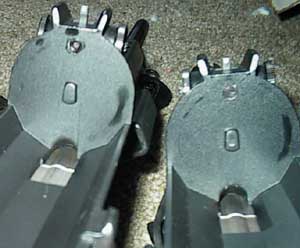 grip. The most natural place to want to put your hand is directly in front
of the trigger guard, and the guard itself is even shaped and ridged to
enhance grip here. The problem is, that the balance of the gun shifts forward
as the magazine empties, and this makes you instinctively move your hand
up to cradle the gun. This will place your hand directly under the downward
facing ejection port; very embarrassing. I tend to put my weak hand up under
the barrel, on the vented shroud around it. This works well, and is more like
a machine gun cradle than a pistol stance.
grip. The most natural place to want to put your hand is directly in front
of the trigger guard, and the guard itself is even shaped and ridged to
enhance grip here. The problem is, that the balance of the gun shifts forward
as the magazine empties, and this makes you instinctively move your hand
up to cradle the gun. This will place your hand directly under the downward
facing ejection port; very embarrassing. I tend to put my weak hand up under
the barrel, on the vented shroud around it. This works well, and is more like
a machine gun cradle than a pistol stance. Other than the bottom throw of the ejection port, and a certain amount of knowledge of how to handle, load, and maintain the magazines, there is really very little to using these guns. I have included some photos for those who have not had the chance ot handle or closely examine a Calico. The first shows the proper grip, and method used to remove the magazine. Note the magazine catches which are depressed, and become "ears", allowing the removal of the magazine. The second picture shows the front of the guns, with the magazines removed. Note the "upside down" feed ramp which feeds down from the magazine, which is mounted above the bolt. The rounded, oblong projections in the centers of the forward edges of the receivers (directly under the sights) are the forward magazine catches. The third photo shows the bottom of the Calico, and you can see the ejection port just in front of the trigger guard. Towards the bottom of the photo, you can see the cocking lever. Straddling the very front of the trigger guard, is the spindle upon which the ambidextrous safety pivots.
 The bottom most picture shows the two versions of the Calico Liberty, 9mm,
side by side. As is readily apparent, there is little physical difference,
and virtually no mechanical difference between the two. The increase in
barrel, and shroud length, along with a slight difference in the shape of
the shroud (to accept the stock rails when the stock is collapsed), and
the addition of an extendable stock, are the only features to distinguish
the two, closely related, weapons.
The bottom most picture shows the two versions of the Calico Liberty, 9mm,
side by side. As is readily apparent, there is little physical difference,
and virtually no mechanical difference between the two. The increase in
barrel, and shroud length, along with a slight difference in the shape of
the shroud (to accept the stock rails when the stock is collapsed), and
the addition of an extendable stock, are the only features to distinguish
the two, closely related, weapons. Notable in the side by side photo are the dual magazine catches on either side of the rear of the reciever. Also visible is the two piece construction of the delayed roller block bolt. There is also another view of the downward oriented feed ramp, and the forward magazine catch. The adjustable forward sight is visible, as are the wheels used to adjust it. Forward of this, can be seen the barrel shroud, and through the vent holes, the barrel itself, encased in the return spring for the cocking lever. The differences in the shape of the barrel shroud between pistol and carbine are clearly distinguished here. The guide housings for the extendable slide are visible on the carbine, in contrast to the shorter, and more plain appearing shroud of the pistol. Sling swivels may be seen on the right hand side of both weapons, and a laser sight is visible at the muzzle of the pistol. Consider this to have been a tour.

| The Pistol (link to my other site) | The Carbine (link to my other site) |
| The Calico Pistol (This Site) | The Calico Carbine (This Site) |
| Home | The Weapons |